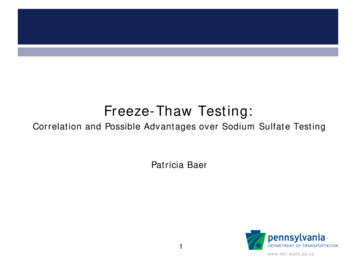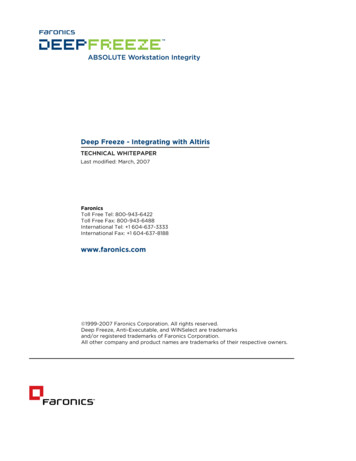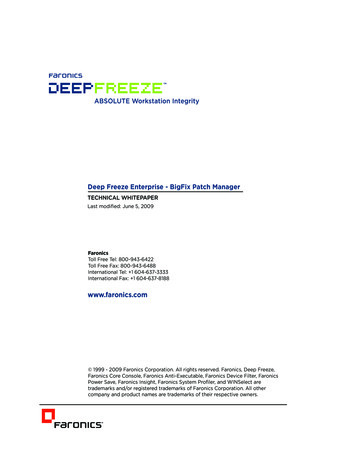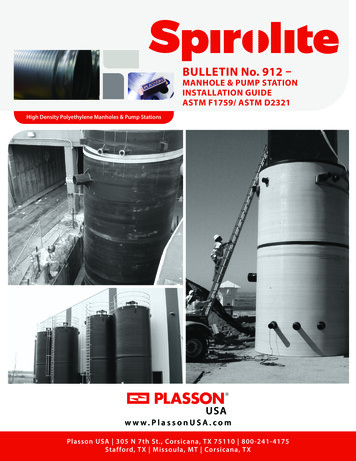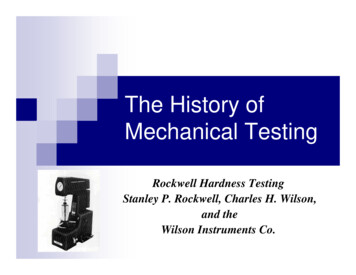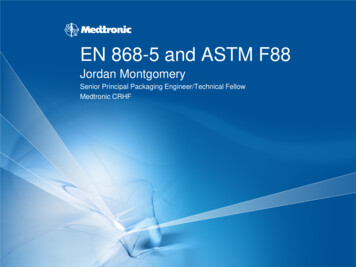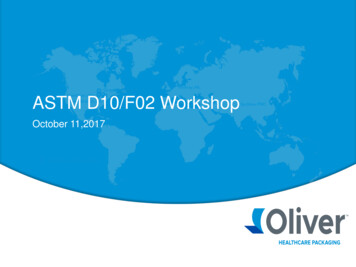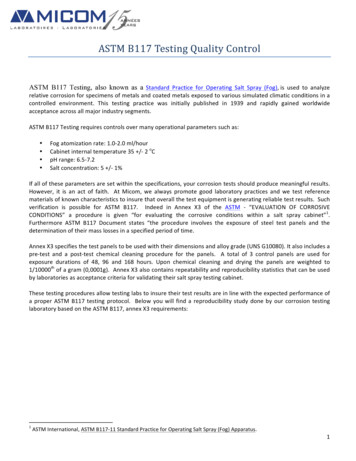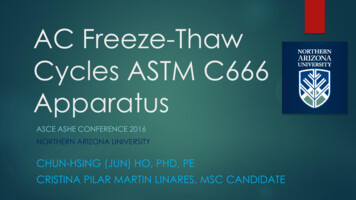
Transcription
AC Freeze-ThawCycles ASTM C666ApparatusASCE ASHE CONFERENCE 2016NORTHERN ARIZONA UNIVERSITYCHUN-HSING (JUN) HO, PHD, PECRISTINA PILAR MARTIN LINARES, MSC CANDIDATE
INDEX Introduction Objectives Materials and Testing methods Results and Discussions Conclusions Acknowledgement Questions
INTRODUCTIONFreeze-Thaw Cycling:Alternately loweringtemperature bellowFreezing Point (0 Cor 33 F) and raising itDiurnal Changes in TemperatureVolumetric expansionFreezing of the waterWater within asphalt mixturesCracking of the asphalt
Mean Annual Days of Freeze-Thaw CyclesNorthern Arizona: 250 cycles (annual average)
OBJECTIVES Evaluate feasibility of using ASTM C666 apparatus in asphalt mixturesASTM C666 standard testing standard for pervious concrete Provide a scientific sound material testing procedure to study F-Tcycling in asphalt mixtures (compare to AASHTO T283)
AASHTO T283 Objective: Determine the resistance of asphalt tostripping Specimens are compacted to air voids of 6 to 8 % Specimens undergo Freeze-Thaw cycle and thenare tested in the IDT Tensile strength ratio (TSR) is calculated F-T cycle process: Dry specimens wrapped in plastic bag and placedin a water bath at 25⁰C for 2 h. Specimens are then placed in a freezer at -18⁰C for24 h.
AASHTO T283However The method was never intended to simulate F-T cycles It is difficult to maintain temperature at a constant rate in a watertank Specimens are prepared using Marshall mixture test; incompatiblewith Superpave mix design Issues with repeatability and reproducibility and questionablepredictive results Highly variable due to allowable saturation levels
ASTM C666 Objective: Determine the resistance of concrete toF-T cycles Calculate durability factor and weight change;length change is optional F-T cycle process: Simulation using a F-T chamber Alternately lowering the temperature from 4 to -18⁰C andraising it from -18 to 4⁰C, in between 2 to 5 h 2 different procedures 300 cycles total
ASTM C666However Method designed for testing pervious concrete but promising fortesting asphalt mixtures, with some modifications.
MATERIALS AND TESTING METHODS Paving Project Mix Design Information Freeze-Thaw Cycle Test Bending Beam Rheometer
Paving ProjectLayout of asphalt overlay project at NAU In 2-lanes roadway: overlay project(136 meters Length x 5.1 metersWidth per lane) Rubberized modified asphalt (RMA)and fiber reinforced asphalt (FRA),on each lane Samples collected and sent to NAUlab, where specimens of 150 mm indiameter and 110 mm in height wereproduced in SGC
Mix Design InformationMix DesignRMAFRANominal Material Aggregate Size (NMAS)½” (12.5mm)½” (12.5mm)Asphalt BinderPG 64-28 TRPG 58-28Percent of asphalt binder, %6.905.20Bulk specific gravity, Gmb2.432.45Theoretical max. specific gravity, Gmm2.532.55Percent air void, %4.203.90Voids in mineral aggregate filled (VMA), %19.014.9Percent voids filled (VFA), %77.973.9
Freeze-Thaw Cycle Test ASTM C666 mold: 16.5” x 3.5”x 4.6” (length x width xthickness) Specimens of 4.5” x 2.5” x 4.5”(length x width x thickness) 100% saturated condition
Freeze-Thaw Cycle Test Temperature cycling from 4 to -18 C Ranges of cycles: 0, 100, 150, 200, 250, 300 cyclesF-T cycling range
Bending Beam Rheometer Thin beams of 12.7 mm x 6.35 mm x 127mm (width x thickness x length) Creep compliance data at 60 seconds Temperature superposition Principle.Asphalt binder: PG 64-28 TR and PG 58-28.Testing temperatures: -12 C, -18 C, -24 C
RESULTS AND DISCUSSIONS Stiffness vs. Number of Cycles ANOVA Linear Viscoelastic Analysis Prediction Relaxation Modulus Field Performance
Stiffness vs. Number of Cycles Objective: Determine the effect of F-T in stiffness Stiffness drops with the increase in the number of cycles Exponential correlationCorrelation in RMA mixturesCorrelation in FRA mixtures
Stiffness vs. Number of Cycles 1/3 drop in stiffness at 150 cycles After 150 cycles, stiffness decrease rate diminishesA. r of F-T -59.3%-24⁰C-6.7%-12.2%-17.6%-23.5%-37.4%
ANOVA- ANALYSIS OF VARIANCE Objective: Statistically determine the significance of that reduction2 data sets from FRA and RMAFor each temperature: -12 C, -18 C and -24 CStiffness difference among all cycles (0, 100, 150, 200, 250, 300) provedto be statistically significantA. MixtureRMAFRATemperature ( C)P-value-123.44 E-07-182.34 E-05-243.76 E-07-121.75 E-05-189.47 E-06-242.21 E-05
LINEAR VISCOELASTIC ANALYSIS Objective: Predict Relaxation modulus behavior Time Temperature Superposition Principle to get a master curve for creepcompliance data (inverse of stiffness) Power Law function is used to model master curve Relaxation modulus and creep compliance are related by theinterconversion equation
Prediction Relaxation Modulus Decrease in relaxation modulus with the increase in the number of cycles After 150 cycles, decrease in relaxation modulus is less significantRelaxation modulus in RMA mixturesRelaxation modulus in FRA mixtures
Field Performance Climatic F-T cycles and fieldperformance of RMA mixtures for2 yearsDateAccumulativeStiffnessAccumulativelength ofdecrease rateF-T cyclescracks (feet)at -18 CMar-141616632%(150 cycles)Jan-155825656%(250 cycles)Feb-1512731659%(300 cycles)
CONCLUSIONS ASTM C666 capable of testing and simulate F-T for asphalt mixtures,as compare to AASHTO T283 standard Stiffness and number of F-T cycles have a exponential correlation ANOVA shows that there are significant differences in stiffnessamong the different F-T cycles Modulus of elasticity and stiffness have a lower rate of decreaseafter 150 cycles Field performance data have close conformity with experimentaldata This research provides positive trend for future research onF-T cycles durable asphalt mixtures
ACKNOWLEDGMENTDr. Shane Underwood at Arizona State University
QUESTIONS?
Freezing Point (0 C or 33 F) and raising it Water within asphalt mixtures Volumetric expansion Freezing of the water Cracking of the asphalt . Mean Annual Days of Freeze-Thaw Cycles Northern Arizona: 250 cycles (annual average) OBJECTIVES Evaluate feasibility of using ASTM C666 apparatus in asphalt mixtures Provide a scientific sound material testing procedure to study F-T cycling in asphalt .File Size: 1MBPage Count: 25
